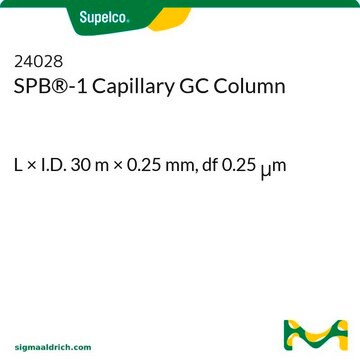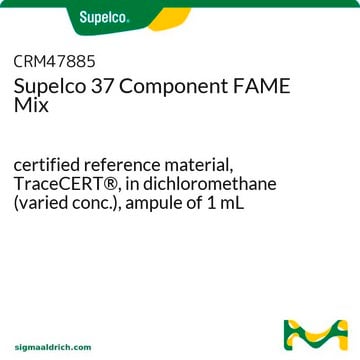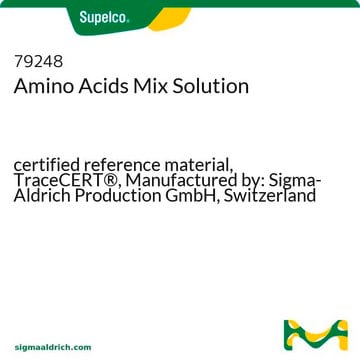Yes.
28564-U
SLB®-5ms Capillary GC Column
L × I.D. 20 m × 0.18 mm, df 0.18 μm
Sinónimos:
GC column, SPB-5, 5% diphenyl, mass spec
About This Item
Productos recomendados
Materiales
fused silica
Nivel de calidad
Agency
Standard Method 6040D
EN 2005/108/EC
EPA 610,625,8015,8082,8100,8141,8270,OLM04.2 SVOA
EPA TO-13,IP-8,8270,525.2,608.1/608.2,608/8081/OLM04.2 PEST
JMHLW
NIOSH 2530,5503
OSHA 62
meets requirements for USP G27 and G36
suitable for EPA 1613
cumplimiento norm.
FDA LIB 4423
Parámetros
-60-340 °C temperature (isothermal)
-60-360 °C temperature (programmed)
Valor Beta
250
df
0.18 μm
técnicas
GC/MS: suitable
gas chromatography (GC): suitable (fast GC)
L × D.I.
20 m × 0.18 mm
grupo activo de la matriz
Bonded and highly crosslinked; silphenylene polymer virtually equivalent in polarity to poly(5% diphenyl/95% dimethyl siloxane) phase
aplicaciones
agriculture
chemicals and industrial polymers
cleaning products
clinical
cosmetics
environmental
flavors and fragrances
food and beverages
forensics and toxicology
industrial hygiene
life science and biopharma
personal care
petroleum
pharmaceutical (small molecule)
tipo de columna
capillary non-polar
¿Está buscando productos similares? Visita Guía de comparación de productos
Categorías relacionadas
Descripción general
USP Code: This column meets USP G27 and G36 requirements.
Phase:
- Bonded and highly crosslinked
- Silphenylene polymer virtually equivalent in polarity to poly(5% diphenyl/95% dimethyl siloxane)
- ≤0.32 mm I.D.: -60 °C to 340 °C (isothermal) or 360 °C (programmed)
- ≥0.53 mm I.D.: -60 °C to 330 °C (isothermal) or 340 °C (programmed)
Otras notas
Información legal
Aplicación
disolvente
Elija entre una de las versiones más recientes:
¿Ya tiene este producto?
Encuentre la documentación para los productos que ha comprado recientemente en la Biblioteca de documentos.
Los clientes también vieron
Artículos
The Derivatization and Analysis of Amino Acids by GC-MS
Supel™ QuE Verde combines a novel carbon with zirconia coated silica (Z-Sep+) to provide an optimum balance between planar pesticide recovery and color removal.
Analysis of Tetrahydrocannabinol (THC) and Carboxytetrahydrocannabinol (THCCOOH) in Surface Waters by SPME and GC/MS
Extraction of Permethrin Pesticides from Spinach Using QuEChERS Methodology with Automated Shaking
Protocolos
There are three types of analyses: GRO, DRO, and TPH. The published methods are simply variations of these to meet the different analytical needs of the individual agencies.
Separation of Cholesterol; Brassicasterol; Campesterol; Stigmasterol; β-Sitosterol
Complete workflow for the comprehensive analysis of terpenes in cannabis
Chromatograms
suitable for GCsuitable for GC-
Would you recommend SLB™-5ms Capillary GC Columns for all applications instead of Equity-5, SPB-5, PTE-5, MDN-5, and MDN-5S?
1 answer-
Helpful?
-
-
What if my method does not allow me to change to SLB™-5ms Capillary GC Columns?
1 answer-
These methods typically specify a 5-type column (DB-5 or equivalent). The SLB-5ms satisfies that requirement.
Helpful?
-
-
Who uses SLB™-5ms Capillary GC Columns?
1 answer-
Any analyst with the need for a non-polar column. Some applications include boiling point separations, GC-MS analyses of semivolatiles, and GC-ECD analyses of pesticides/PCBs. It is estimated that non-polar columns account for 51% of the worldwide column market.
Helpful?
-
-
What is the Department of Transportation shipping information for this product?
1 answer-
Transportation information can be found in Section 14 of the product's (M)SDS.To access the shipping information for this material, use the link on the product detail page for the product.
Helpful?
-
-
How does the SLB™-5ms Capillary GC Column differ from our other 5-type columns?
1 answer-
Many of our other 5-type columns (Equity-5, SPB-5, PTE-5, MDN-5, and MDN-5S) incorporate a siloxane polymer (backbone comprised of Si and O atoms only, side groups are either methyl or phenyl). The SLB-5ms column incorporates a silphenylene polymer (backbone comprised of Si and O atoms plus some phenyl groups, side groups are either methyl or phenyl).
Helpful?
-
-
What are the benefits of the SLB™-5ms Capillary GC Column over other manufacturers’ -5ms columns?
1 answer-
The SLB-5ms excels in several performance criteria.· Low Bleed. The highly crosslinked silphenylene polymer chemistry reduces column bleed to a very low level, resulting in greater signal-to-noise level, allowing lower detection levels.· Inertness. The proprietary surface deactivation reduces interactions between analytes and the column surface, resulting in sharper peak shapes, allowing lower detection levels.· Durability. With the highest published maximum allowable operating temperature (MAOT) of any -5ms column, SLB-5ms columns are designed for long life.· Consistency. Innovative manufacturing processes result in decreased column variability, ensuring that the next column is as good as the last.
Helpful?
-
Active Filters
Nuestro equipo de científicos tiene experiencia en todas las áreas de investigación: Ciencias de la vida, Ciencia de los materiales, Síntesis química, Cromatografía, Analítica y muchas otras.
Póngase en contacto con el Servicio técnico






